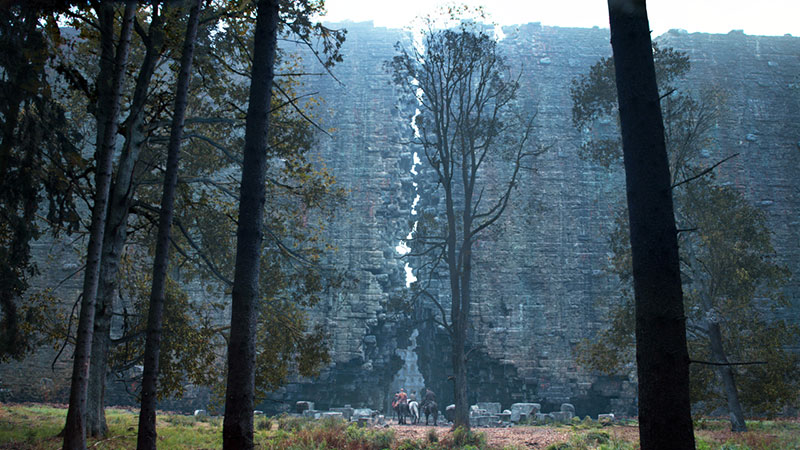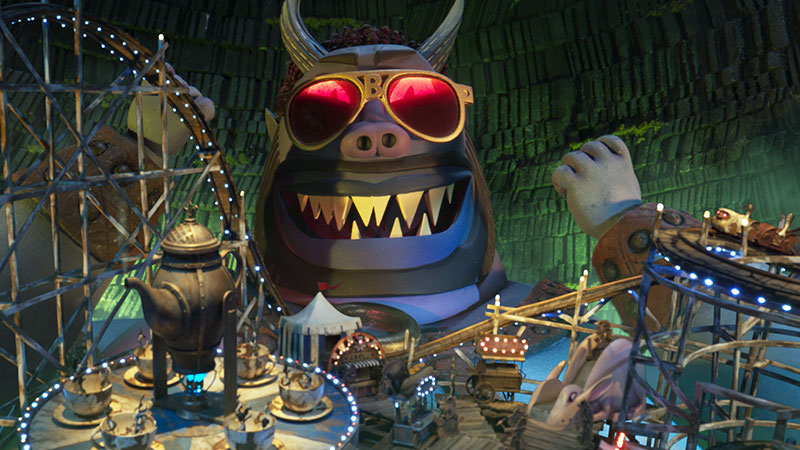DFX Supervisor Dean Koonjul at Union VFX talks about building the mystical landscapes and cityscapes of this fantasy TV series, digital doubles and FX animation of the Shadow Monster.

Union VFX recently shared a reel of their work from ‘The Wheel of Time’, Amazon Studios’ series based on the original fantasy novels by Robert Jordan. The story is set in a world where magic exists, but is accessible only by a few.
The story follows the journey of Moiraine, a member of Aes Sedai, an organisation of women who can channel the One Power. Moiraine leads a group of five young people as they search for the reincarnation of the Dragon who will determine the fate of humanity.
Led by DFX Supervisor Dean Koonjul, Union delivered wide and varied VFX for the show, working with production VFX supervisor Julian Parry and VFX producer Jakub Chilczuk. The team created full CG environments as well as top-up extensions to the practical sets. They also delivered extensive FX animation for the Shadow Monster, known as Mashadar, in the ruined city of Shadar Logoth, formerly a great capitol city now abandoned and haunted by this subtle but deadly Monster.
Union’s other VFX work included digi-double animation and FX as well as the addition and integration of CG props with live-action actors.
Building Shadar Logoth
The Production wanted the architecture of Shadar Logoth to evoke a once powerful and opulent city, with motifs and ornate detailing reminiscent of, but not recognisable as coming from any specific real world location. Dean said, “We began by gathering written references and descriptions of Shadar Logoth based on the production script and the original books. We then tried to identify examples of similar architecture, in relation to the overall city layout, roofing styles, key buildings such as temples and palaces and so on, and old city fortifications and boundary walls.
“The Production had supplied our team with some great concept art, and alongside that and the on-set photography, we took inspiration from influences ranging from Rajasthan in India to ancient Persia, Istanbul, Cairo and Fes.”
The concepts served as their starting point for much of the VFX work in and around Shadar Logoth. “The concept art was also our guide when blocking the city layout for several of the wider vistas,” said Dean. “We used Lidar scans of the set and high res textures from the shoot as our base to recreate the city at ground level and then remodelled and textured to extend upwards and outwards, creating a wider expanse of city blocks.
“Because of the heavy detail and texturing, we started with around 10 to 12 buildings that we worked up to varying levels of detail, depending on how close they came to the camera. These building blocks were randomly scattered to build out the greater expanse of the city, and additional buildings with more bespoke details were modelled and placed among them to create the final city layout.”
No Refuge
At a turning point in the story, Moraine and her companions are forced to hide in Shadar Logoth to escape being hunted down by their enemies. As Mashadar begins to encroach on them, it engulfs and kills one of their horses, forcing the group to split into three. Two of them slip through a crack in a massive stone wall, two others escape through an underground passageway, and the last two must jump from the city walls into the moat below," Dean said.
“Our recreated city was approximately 2km in diameter with a surrounding wall around 30m or 40m high. We were aware that the scene could become disorientating as our heroes escaped in different directions through the city streets, in a fairly fast-paced chase sequence.
“So we decided to map out the city’s location in relation to its surrounding environment of the river, plains, mountains and forest, and to also plot our heroes’ escape routes to make sure our background environments and shot continuity made sense. Luckily, lots of Wheel Of Time fan-based maps are available online, so we used these as reference to remain as true to the story geography as possible.”

Stone Wall
The huge, broken stone wall that Moraine and Lan her protector escape through is an impressive asset. Dean said, “The concepts conveyed the imposing nature and height of the wall, and we were able to use them as a layout guide for the crack. We went on to research man-made stone ruins and other natural rock walls as reference for weathering and texture on the wall’s surface.
“From there, the on-set build of sections on top of the wall and parts of its exterior informed the size and shape of the blocks that were used to construct it. First we built and textured a section of unbroken wall in Maya, which we could vary and tile around the city for use in other shots. Then we modelled a more bespoke section for the crack, and later the opening where Lan and Moiraine escape, which was inserted into our main wall structure. Finally, we added a digital matte painting pass to enhance the textures and detail across the wall.”
Consuming Fungus
Creating the FX animation for the Mashadar the Shadow Monster in Shadar Logoth started with a fairly terrifying brief and eventually turned to nature for the right kind of inspiration for its look and movement. The brief was to create something ‘dark and menacing that lurks and emerges from the shadows’, to pursue any living thing in its path, dissolving it to leave only a pile of black gravel. “Rafe Judkins, the Show Runner, wanted the sequence to feel like a horror chase, instigated by the attack on the unsuspecting horse, which in turn needed to be gruesome and realistic enough to create peril without becoming gratuitous or overly sadistic,” said Dean.
“We based our initial tests on some great reference we found of ‘forest slime mould’ – a yellow goo-like substance that scours the forest floor devouring all decaying matter in its path. So, it was great to hear when Julian also described the desired effect as a ‘consuming fungus’! We continued to explore other options for more of a burn effect when the Shadow Monster attacks the horse, which involved watching some pretty gruesome footage of all manner of things being dissolved in acid baths.”

The Darkest Shadow
Although they experimented first with a literally ‘shadowed’ look for the monster so that it lived up to its name, it became clear that its surface had to be textured to catch some light and better describe its movement in the scene. Dean said, “Rafe Judkins and Julian Parry, the overall Show VFX Supervisor, didn’t want the monster to appear too shiny, wet or oily either. Instead, we developed a number of lighting and utility AOVs to help dial in specular and textural detail as needed.
“We used the environment geometry for the its animation surface and the scene lighting from our CG extensions to light and integrate the effect. In comp we used the texture and lighting of the plate photography to help with shadow displacement and lighting to further integrate the effect. We also employed some more subtle, story-lead treatments, such as increasing the overall ambient occlusion in the scene as the on-screen presence of the Shadow Monster increased.”
Horse Disintegration
When their horse is overcome by the Monster, the viewers have a clear idea of what the heroes are up against. But the team at Union first had to build a photoreal horse. Dean said, “We modelled and textured a CG horse in Maya based on reference and the real horse captured in surrounding shots.
“Knowing that the horse needed to disintegrate across a few shots, we also modelled the skeleton, muscle and fat underneath the skin. These layers were then physically simulated in Ziva to give realistic motion. Fur systems were created for the hair for the body, mane and tail before being exported to Houdini for simulation and rendering.”
Since they had already created a system for the shadow monster growing over the various surfaces of the city models, they moved a similar system to the model of the horse but added a component of organic disintegration of the horse geometry. As well as eroding the form of the horse itself, layers of particle grit, grain and volumetric dust were added to give more detail and physicality.

Animated Leap
As mentioned, two of the characters end up jumping from the city walls into the moat below. “This was the only fully CG shot we delivered, for which no practical plate element was shot,” Dean reflected. “But we did have the great Production concept art to guide us for its tone and framing. We also had the surrounding shots as reference to match, so we chose an appropriate one and elected to use the camera and lens from that one when blocking the layout and camera move for the wall jump.
"We used our CG asset for the wall, with an additional layer of DMP to enhance foreground detail, and a procedural approach for the river. The more distant background environment was a DMP projected onto some simplified blocking geometry. We added some FX atmos layers to help create volume when lighting the scene. The splash in the end was a mixture of CG FX and practical 2D library elements."
The two characters were also fully CG, created as digi-doubles from Lidar scans of the two actors, which the team then textured and rigged to animate in the scene. "Of course, falling motion such as this, isn't something easy to recreate using motion capture, so we knew keyframe animation would give us the most control to get a physically plausible and believable performance," Dean said.
"We looked at a lot of cliff jumping clips from the internet and movie history (‘Butch Cassidy and the Sundance Kid’ being a classic) when researching the fall animation. We had the tighter, practical shot of them at the top of the wall to match when posing them at the start of the jump, but the overall motion of the fall was keyframe-animated. After that, we could run cloth simulations for their costumes." www.unionvfx.com


















